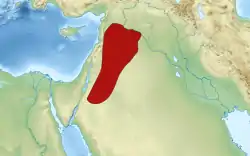Tanukhids
The Tanûkhids (Arabic: التنوخيون) or Tanukh (Arabic: تنوخ) were a confederation of Arab tribes, sometimes characterized as Saracens. They first rose to prominence in northern Arabia and south of Syria in the 3rd century BC. Both Lakhmid and Tanukhid inscriptions have been found at Umm el-Jimal in Jordan and Namara in Syria. The ancient Tanukhi tribal confederation was largely taken over by several branches of the large Azd and Quda'a tribe. Their main base during the time of their most famous ruler, Queen Mavia, was in Aleppo.[1]
| Historical Arab states and dynasties |
|---|
 |
Tanukh تنوخ | |||||||||||||
|---|---|---|---|---|---|---|---|---|---|---|---|---|---|
| 196 AD–c. 1100 AD | |||||||||||||
 | |||||||||||||
| Capital | Qinnasrin (main base) | ||||||||||||
| Common languages | Arabic | ||||||||||||
| Religion | Arab Paganism, Christianity, Islam | ||||||||||||
| Demonym(s) | Tanukhi | ||||||||||||
| Government | Chiefdom | ||||||||||||
| Chief/King | |||||||||||||
• 196–231 AD | Malik ibn Fahm | ||||||||||||
• 233–268 AD | Jadhima ibn Malik | ||||||||||||
• Until 375 AD | al-Hawari | ||||||||||||
• 375–425 AD | Queen Mavia | ||||||||||||
| Historical era | Classical Age to the Early Middle Ages | ||||||||||||
• Established | 196 AD | ||||||||||||
• Conversion to Christianity | 3rd or 4th century | ||||||||||||
• Revolt of Queen Mavia | 378 AD | ||||||||||||
• Conversion to Islam | 8th century | ||||||||||||
| 1096–1099 AD | |||||||||||||
• Disestablished | c. 1100 AD | ||||||||||||
| |||||||||||||
History
In the late 2nd century, a branch of the tribe of Azd, from Southern Arabia, migrated to al-Hasa where Tanukhids were settling. The Azdies allied with the Tanukhids, becoming part of the confederation. The two sheikhs (tribal leaders) gave up the rule to Malik ibn Fahm (196–231), who led them into what is now Iraq and Syria, and after skirmishing with other tribes in the area, he controlled all of Jordan, and parts of Iraq, he was succeeded by his brother 'Amr ibn Fahm who reigned for a short period, and after him Jadhima ibn Malik reigned (233–268). After Jadhima's death, he was succeeded by his sister's son 'Amr ibn Adi, a Lakhmid, because Jadhima had no sons, thus establishing the Lakhmid dynasty. Other Tanukhids settled in Syria. 'Amr ibn 'Adi is attested in the Arab legends to have been the sole victor in the war against Zenobia's Palmyrene Empire, but these myths "are probably an amalgam of fact and fiction."[2]
In the 4th century AD, the Tanukhids formed a major grouping of Rome's allies in the East, ranging from Syria in the north to the Gulf of Aqaba, areas into which they had migrated from southern Arabia after the rise of Sassanian influence in Yemen a century earlier. They are reported to have been devoted to Christianity, Thomas the Apostle[3] and monasticism, with many monasteries associated with the tribe.[4] The Tanukhids played a key role in the defeat of Zenobia's forces by Emperor Aurelian and served as foederati in the Roman East – the first Arab tribe to do so.[5] In 378, their Queen Mavia led them in a revolt against Emperor Valens. A truce was struck and was respected for a time, with Mavia even sending a fleet of cavalry in response to Roman requests for assistance in staving off an attack by the Goths. The alliance crumbled under Theodosius I, with the Tanukhids again revolting against Roman rule.[6]
The Tanukhids were Christianised in the 3rd or 4th centuries, likely while in the eastern half of the fertile crescent, and by the 4th century they were described as having a "fanatic zeal for Christianity" and were "zealous Christian soldiers" in the 6th century.[7] In the 7th century, during the Muslim conquest of the Levant, the Tanukhids fought with the Romans against the Muslims, including in the Battle of Yarmouk. After Yarmouk, their status as foederati ended.[8] They were described as an "autonomous Christian community in Bilad al-Sham" up until the reign of the Abbasid caliph al-Mahdi (r. 775–785), after which they appear as Muslims. Their conversion to Islam is believed to have been forced upon them by al-Mahdi.[9][10]
In the 11th century, they were joined by Qahtani tribes from southern Arabia, such as the Banu Ma'an. The Tanukhids of Mount Lebanon inaugurated the Druze community in Lebanon, when most of them accepted and adopted the new message, due to their leadership's close ties with then Fatimid caliph al-Hakim bi-Amr Allah.[11] The Ma'an tribe settled in the Lebanon Mountains on order of the governor of Damascus to defend against the encroaching Crusaders. Most Ma'ans in Lebanon later became Druze. They were later defeated by a rival Qays tribe who had also become Druze, the Qaysi Druze. The central parts of Mount Lebanon were described as a Tanukhid stronghold, housing both Druze and Shiite Muslims until the start of the 14th century.[12]
See also
References
- Ball, Warwick (2001), Rome in the East: The Transformation of an Empire, Routledge, ISBN 0-415-11376-8 p. 98-102
- Southern, P. (2008) Zenobia: Palmyra's Rebel Queen, Continuum, London, p.108
- Gabriel Said Reynolds (2012). The Emergence of Islam: Classical Traditions in Contemporary Perspective. Fortress Press. ISBN 9781451408126.
The Tanukhids (whose territory spread from southwestern Iraq to southern Syria) were known for their devotion to Saint Thomas...
- Irfan Shahid (2010). Byzantium and the Arabs in the Sixth Century, Volume 2, Part 2 (illustrated ed.). Harvard University Press. p. 134. ISBN 9780884023470.
- Mohammad Rihan (30 May 2014). The Politics and Culture of an Umayyad Tribe: Conflict and Factionalism in the Early Islamic Period. I.B.Tauris. p. 43. ISBN 9781780765648.
- Ball, 2001, pp. 97-102
- Irfan Shahîd (1 Jan 1984). Byzantium and the Arabs in the Fourth Century (illustrated, reprint ed.). Dumbarton Oaks. pp. 419, 422. ISBN 9780884021162.
- Hamilton Alexander Rosskeen Gibb; Bernard Lewis; Johannes Hendrik Kramers; Charles Pellat; Joseph Schacht (1998). The Encyclopaedia of Islam, Volume 10, Parts 163-178. Brill. pp. 191–2.
- Irfan Shahid (2010). Byzantium and the Arabs in the Sixth Century, Volume 2, Part 2 (illustrated ed.). Harvard University Press. p. 430. ISBN 9780884023470.
- Lia van Midden (1993). Polyphonia Byzantina: Studies in Honour of Willem J. Aerts. Egbert Forsten. p. 70. ISBN 9789069800547.
- William Harris (19 Jul 2012). Lebanon: A History, 600-2011 (illustrated ed.). Oxford University Press. p. 46. ISBN 9780195181111.
- Barut, Mohammed Jamal (January 2017). حملات كسروان في التاريخ السياسي لفتاوى ابن تيمية. ISBN 9786144451366.
Bibliography
Further reading
- Shahîd, Rome and the Arabs: a Prolegomenon to the Study of Byzantium and the Arabs (Washington: Dumbarton Oaks) 1984. The opening volume of Shahîd's multi-volume history of Byzantium and the Arabs.